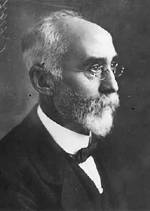Difference between revisions of "Hendrik Lorentz"
m (→Lorentz Transformation and Einstein's theory: change of chapter name in reference) |
(tweaking paragraph on Lorentz Contraction in introduction, creating wiki-link for page on the effect.) |
||
| Line 6: | Line 6: | ||
The existence of [[electron]]s had not yet been proven, but Lorentz proposed that [[light]] waves resulted from oscillations of an atomic electric charge. In 1902, Lorentz received the [[Nobel Prize]] along with his student for developing a mathematical theory of the electron. | The existence of [[electron]]s had not yet been proven, but Lorentz proposed that [[light]] waves resulted from oscillations of an atomic electric charge. In 1902, Lorentz received the [[Nobel Prize]] along with his student for developing a mathematical theory of the electron. | ||
| − | Lorentz's most famous work is the Lorentz | + | Arguably, Lorentz's most famous work is the [[Lorentz Contraction]], which he introduced in 1904.<ref>http://www-groups.dcs.st-and.ac.uk/~history/Biographies/Lorentz.html</ref> This describes the effect in which an object will decrease in length along the axis parallel to the direction in which it is traveling. While this effect occurs at any non-zero velocity, it is generally considered negligible at velocities below a significant fraction of [[Speed of light|''c'']]. |
Lorentz always hoped that [[Quantum mechanics|quantum theory]] could be described by classical mechanics. | Lorentz always hoped that [[Quantum mechanics|quantum theory]] could be described by classical mechanics. | ||
Revision as of 03:58, May 10, 2013
Hendrik Lorentz (1853-1928) was a brilliant Dutch physicist who, in addition to Henri Poincaré, developed a mathematical theory of relativity.
Lorentz's first achievement was in his doctoral thesis when he refined Maxwell's electromagnetic theory in his doctoral thesis. In 1878, he became professor of mathematical physics at Leiden University. Later he moved to the Teyler Institute, Harlem.
The existence of electrons had not yet been proven, but Lorentz proposed that light waves resulted from oscillations of an atomic electric charge. In 1902, Lorentz received the Nobel Prize along with his student for developing a mathematical theory of the electron.
Arguably, Lorentz's most famous work is the Lorentz Contraction, which he introduced in 1904.[1] This describes the effect in which an object will decrease in length along the axis parallel to the direction in which it is traveling. While this effect occurs at any non-zero velocity, it is generally considered negligible at velocities below a significant fraction of c.
Lorentz always hoped that quantum theory could be described by classical mechanics.
Lorentz Transformation and Einstein's theory
Mathematical investigations performed by Lorentz, Fitzgerald and Larmore shown that Maxwell's Equations used for description of electromagnetic field do not conserve the covariant character with respect to Galilean transformations. That's why he worked out equations for transformation of coordinates that allow for keeping the identical form of Maxwell's equations in all inertial systems. In these transformations the spacial and time coordinates are mutually interrelated and the meaning of relativity term is extended from space to time. A. Einstein set these Lorentz transformations as the fundamental equations for description of the space-time structure in his Special Theory of Relativity, he however removed the assumption of the absolute frame of reference with respect to which they were expected to be interpreted. Lorentz in physical aspect of his theory left in force the aether hypothesis. The consequences of Lorentz transformation for motion at high speeds are contraction and dilatation effects, which Lorentz ascribes to lengths and time intervals and not to medium (aether or absolute space) as such. Lorentz never to his last day gave up the idea of plausibility of his explanation compared to the one from Einstein. H.Dingle points out that it is not possible to decide experimentally between Lorentz's and Einstein's theory and the only indirect experiment is Michelson-Morley experiment.[2] Berlinski states that H.Lorentz was among only a few physicists wondering forlornly over Einstein's placing formal restrictions (in terms of postulates of special relativity) on theories that describe the physical world - in an attemp to resolve difficulties physicists faced with respect to symmetry in nature whose exisence no one suspected but that had been ratified by established constraint.[3]
References
- ↑ http://www-groups.dcs.st-and.ac.uk/~history/Biographies/Lorentz.html
- ↑ Michal Andrle. Whitheadova Filosofie Přírody (in Czech). Prague: Charles University, 154-155. ISBN 978-80-87378-22-9.
- ↑ David Berlinski (2009). "The state of the Matter", The Deniable Darwin. Seattle, USA: Discovery Institute Press (reprinted from Commentary February 1998 by permission), 538. ISBN 978-0-9790141-2-3. “A symmetry in nature whose existence no one suspected had been ratified by a constraint whose power no one had recognized. The result was a great success, with only a few senior physicists, such as Hendrik Lorentz, wondering forlornly what it was all about.”
